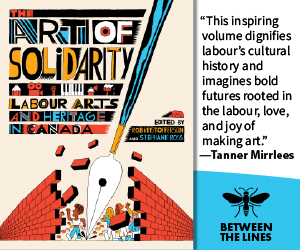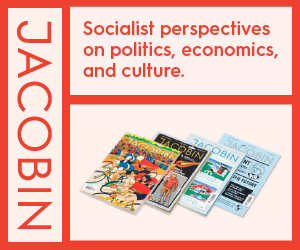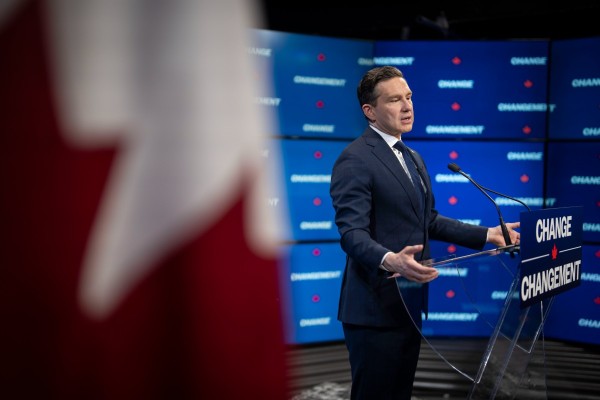What the Emergencies Act reveals about civilian policing in Ottawa
There are growing elements of the repressive forces of the state that no longer adhere to the norms of bourgeois democracy

Police officers in Ottawa during the Freedom Convoy occupation. Photo by Franklin McKay/Shutterstock.
Prime Minister Justin Trudeau’s decision to invoke the Emergencies Act to deal with the fascist “trucker” convoy has been met with a mix of support, criticism, and confusion. While Trudeau and his government claim that this is necessary to respond to the situation, many of us on the left remain skeptical, having witnessed first-hand the power of police protest control in the absence of the Emergencies Act. So why did the federal government take such a drastic step?
First, the border blockades at Coutts in Alberta and the Ambassador Bridge in Ontario were effective enough that they began to hurt sections of big capital. Officials in Michigan used the opportunity to champion Buy-American initiatives. In Windsor, a coalition of auto companies was able to obtain an injunction against the blockade. And with nearly 300 million in trade a day being blocked, Trudeau’s call with Biden surely underscored the need for the Canadian state to step in and defend the interests of capital. The Emergencies Act both gives the federal government the authority to pre-emptively take extra steps to protect critical infrastructure, but also signals to the Americans that Canada remains a reliable trading partner.
Second, having been handed marching orders by some sections of big capital and their representatives in the American state, the Trudeau government is hastening to clear the protests. The Emergencies Act gives the federal government greater power to starve the movement financially. With millions in funding pouring in from both domestic and foreign sources, it was necessary to choke the growth of the protest. Banks have since announced that they will be freezing bank accounts associated with the convoy. Further, the Emergencies Act specifically gives insurance companies the ability to pull coverage from truckers involved in the protest, a move that already has some truck owners voluntarily disengaging from the occupation in front of the Parliament buildings.
Most importantly though, the recourse to the Emergencies Act reveals an uncomfortable truth about the state of policing in Canada: the federal government apparently believes that the Ottawa Police Service (OPS) was either unwilling or unable to effectively control the protest movement. The Emergencies Act allows municipal governments to bypass municipal police forces, effectively allowing the civil government of Ottawa to work directly with the OPP and RCMP for protest enforcement. Trudeau himself said that “it is now clear that there are serious challenges to law enforcement’s ability to effectively enforce the law.” His sentiment was echoed by Public Safety Minister Bill Blair, who has no lack of experience in police repression of protests.
As anyone on the left can attest, it seems unlikely that the OPS was simply unable to gain control of the situation. Police forces have reacted with chillingly effective violence to far larger progressive protests. What seems more likely is that the police were reluctant to act against the convoy. Right-wing infiltration of the police and army has long been a concern in the United States, and Canada is not immune. Even the Department of Defence expressed some consternation about the far-right presence in the Canadian military. There are indications that OPS officers were not only sympathetic to the broad political aims of the so-called Freedom Convoy (the Ottawa Police Association spoke out against vaccine mandates for OPS members, initially making them the only municipal workers in Ottawa without a vaccine mandate, but that individual officers actively helped the convoy itself.
Aside from the outright inaction of the OPS in controlling the convoy, videos and photos have emerged which show the police allowing protestors to stockpile fuel, police following protestor-directed traffic control, police helping to erect a protestor tent, OPS members allowing a convoy truck slated for towing to be released, and police retreating from interactions with protestors. Indeed, one truck even hit a police officer while it was leaving the Battle of Billings Bridge; the truck driver was allowed to leave after promising to not hit the officer again. Convoy members openly acknowledged the support they received from police when the protestors gifted the police with roses on Valentine’s Day.
While leaving the area, this driver hit this cop with his car.
— Mackenzie Gray (@Gray_Mackenzie) February 13, 2022
After that happened, the cop went up and asked the driver “So you’re not going to hit me with your vehicle again?”
“No sir” replies the protestor, before he drives off #cdnpoli #ottnews pic.twitter.com/yzjv1bavjQ
Consider the narrative of the right’s infiltration of the police and army. It is very similar to the narrative of leftist outside agitators infiltrating a worksite or other struggle and inflaming the situation. We know that struggles produce their own consciousness, and outside agitators are often nothing more than stories invented by the powerful to delegitimize resistance. Indeed, it isn’t simply that the far-right seeks to infiltrate the police and military, but rather that the practices of the police and military in modern capitalist states—defending capitalism, imperialism, white-supremacy, and so on—actively produce and reproduce new far-right agents. How else can a police officer engaged in racist terror against people of colour justify his actions without recourse to an understanding of racial superiority over their victims? Right-wing infiltration of the repressive apparatuses of the state is less about gaining access to training and resources, and more about gaining access to potential recruits—recruits who have been prepared, indoctrinated, and trained by the institutions of bourgeois democracy itself. This contradiction will become explosive in the coming years.
A question remains though: is the support for the convoy confined to rank-and-file officers, or is it the case that the police brass also supports the convoy movement? Former Chief Peter Sloly may have let his true feelings slip at a meeting of the Police Services Board on February 5, when, responding to frustrations about the occupation dragging on, he replied that people were equally frustrated about pandemic measures. Sloly also came in for significant criticism when it was revealed that he had no plan to use the additional police reinforcements that he had requested; whether or not this was incompetence or complacency is difficult to say. Sloly’s unwillingness to deal with the protests surely did not go unnoticed by his superiors at other levels of the state. After having said that he would not resign, Sloly announced his resignation from his post a few days later. The RCMP and OPP were subsequently given control over the Integrated Command Centre task force, an inter-agency group intended to coordinate efforts between police forces at various levels.
The federal government’s opinion that the RCMP is more willing or able to deal with the convoy is somewhat perplexing given the high level of support for the far-right convoy within multiple repressive arms of the Canadian state. An OPP officer is currently under investigation for openly expressing his support. The RCMP agents at the border blockade at Coutts were filmed hugging protestors as the protestors left, even after a weapons cache was seized and several people were charged with conspiracy to murder RCMP officers. Support even extends into the Canadian military, with an active major having released a support video in which he refers to vaccination as genocide, and various members under investigation for supporting the convoy including members of the elite JTF2. Police have also started to organize themselves into their own far-right, anti-vaccine networks; groups such as Mounties4Freedom and Police on Guard For Thee purport to have members and supporters across multiple police departments at all levels across the country. Only time will tell if the Trudeau government’s assumption that the RCMP will be more loyal will pay off.
In a moment of solidarity with the people, police officers greet, shake hands, and hug the truckers and citizens of the Coutts blockade who stopped traffic for eighteen consecutive days.pic.twitter.com/x0SUsqng7k
— The Vigilant Fox (@VigilantFox) February 15, 2022
Taken together, this all adds up to a troubling conclusion.
If the federal government thought it necessary to invoke the Emergencies Act to bypass a municipal police force, to what extent does civilian control over policing actually exist? Civilian control over the state’s repressive apparatuses, police and the military chief among them, is a cornerstone of bourgeois democracy. This arrangement of power is in fact central to the bourgeois state’s utility to the capitalist class. Rather than being decided through messy and violent contests of force, the ability to run the state is determined through hegemony-building processes, aided by political forms such as brokerage-style political parties and parliaments. While coercion always underlies these forms, especially when marginalized groups attempt to infiltrate the halls of power, there is, by and large, an understanding by the various factions of capital that formal politics will be the means by which governments are decided, as long as those governments continue to act in the service of capital as a whole.
The convoy debacle appears to show that there are elements of the repressive forces of the state, backed by segments of big capital and reactionary small capitalists, who no longer subscribe to this arrangement of power. And, insofar as power and force underlies all of these institutions, if those with a monopoly on “legitimate” violence no longer adhere to the norms of bourgeois democracy, we will quickly find that what pass as democratic institutions are not nearly as powerful nor as permanent as liberalism would have us believe.
In the dying days of the Trump regime, it appeared as though Trump’s wing of the capitalist class in the United States was jockeying for control over various repressive tools of the state as a means of maintaining power in the event of a contested election. Trump replaced the head of the Navy and put in a loyalist as head of the Department of Homeland Security. To test loyalties, the Trump regime began to use bizarre federal police forces such as Immigration and Customs Enforcement (ICE) and Border Patrol to police protests. The result was an unprecedented statement from the American military brass that the military would not intervene in issues related to the election. In the end, after the failed (but police-supported) insurrection of January 6, cooler heads prevailed; Trump was not able to secure a viable hegemony using means outside of the traditionally agreed upon political forms available to him, and so was forced to abdicate the office of president.
While the current reactionary convoy in Canada will not approach the level of strength attained by the January 6 insurrection, police support for the convoy, attested to by the imposition of the Emergencies Act, indicates that the repressive forces of the Canadian state may be more willing than their counterparts in the US to back those sections of capital which seek to overturn the political norms of bourgeois democracy.
Martin Schoots-McAlpine is an organizer, communist, and a PhD candidate at York University. His research focuses on the history of the communist movement in Canada and abroad, as well as the modern Canadian state and its ties to capital.










